University: PROJ6003 Change Management Report on Project Execution
VerifiedAdded on 2022/11/13
|8
|1517
|133
Report
AI Summary
This report provides a comprehensive analysis of project change management, focusing on the processes involved in submitting change requests, the impact of changes on project scope, time, cost, and quality, and the associated risks. The report explores a case study, examining the need for change, such as vendor delays and workforce estimation errors, and proposes solutions like changing vendors and imposing penalties. It includes a sample change request form and concludes by emphasizing the importance of careful monitoring, evaluation, and review before approving project changes, ensuring compliance with organizational policies and guidelines to mitigate risks and achieve project success. The report also highlights the importance of analyzing the feasibility of changes in the context of long-term organizational strategies.
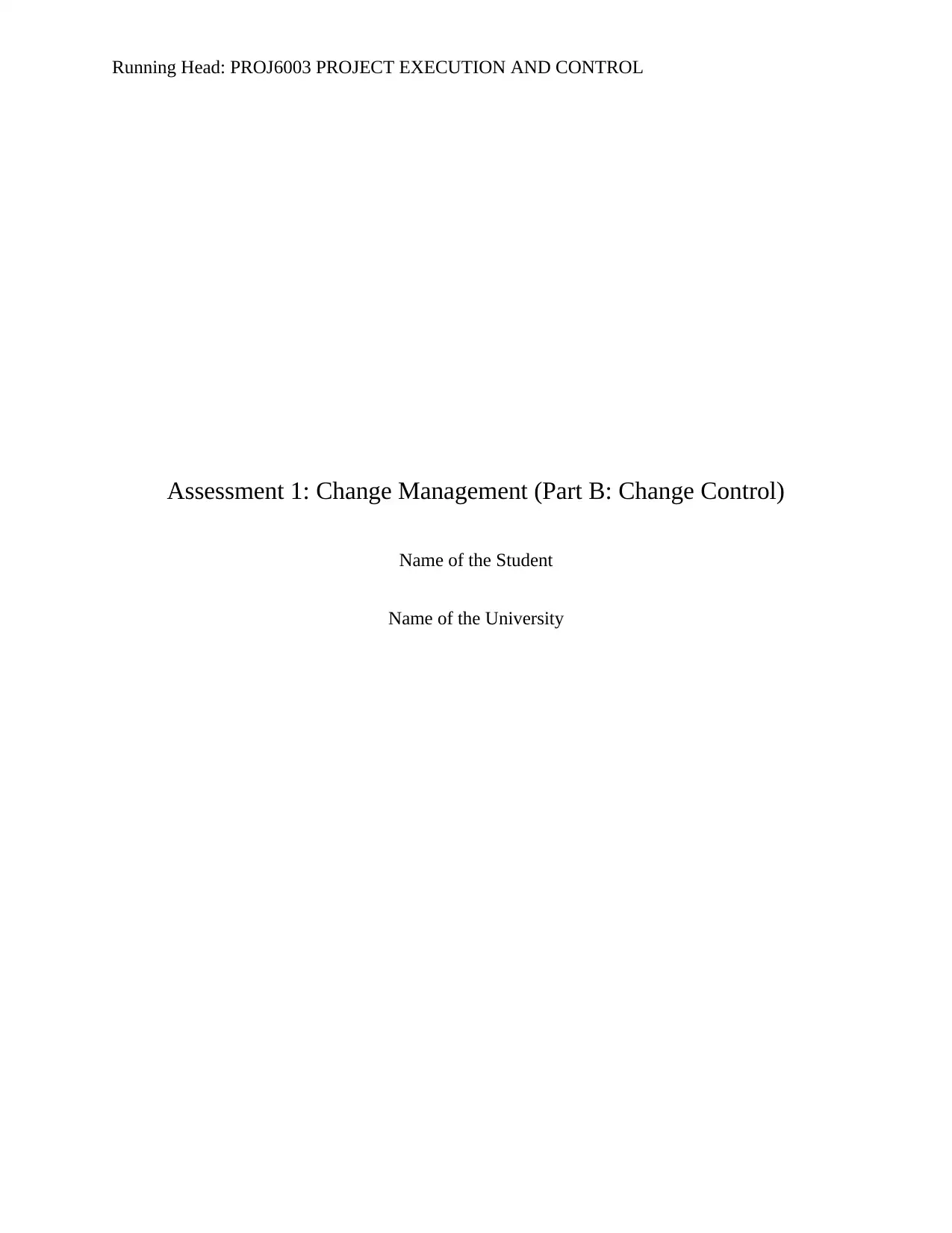
Running Head: PROJ6003 PROJECT EXECUTION AND CONTROL
Assessment 1: Change Management (Part B: Change Control)
Name of the Student
Name of the University
Assessment 1: Change Management (Part B: Change Control)
Name of the Student
Name of the University
Paraphrase This Document
Need a fresh take? Get an instant paraphrase of this document with our AI Paraphraser
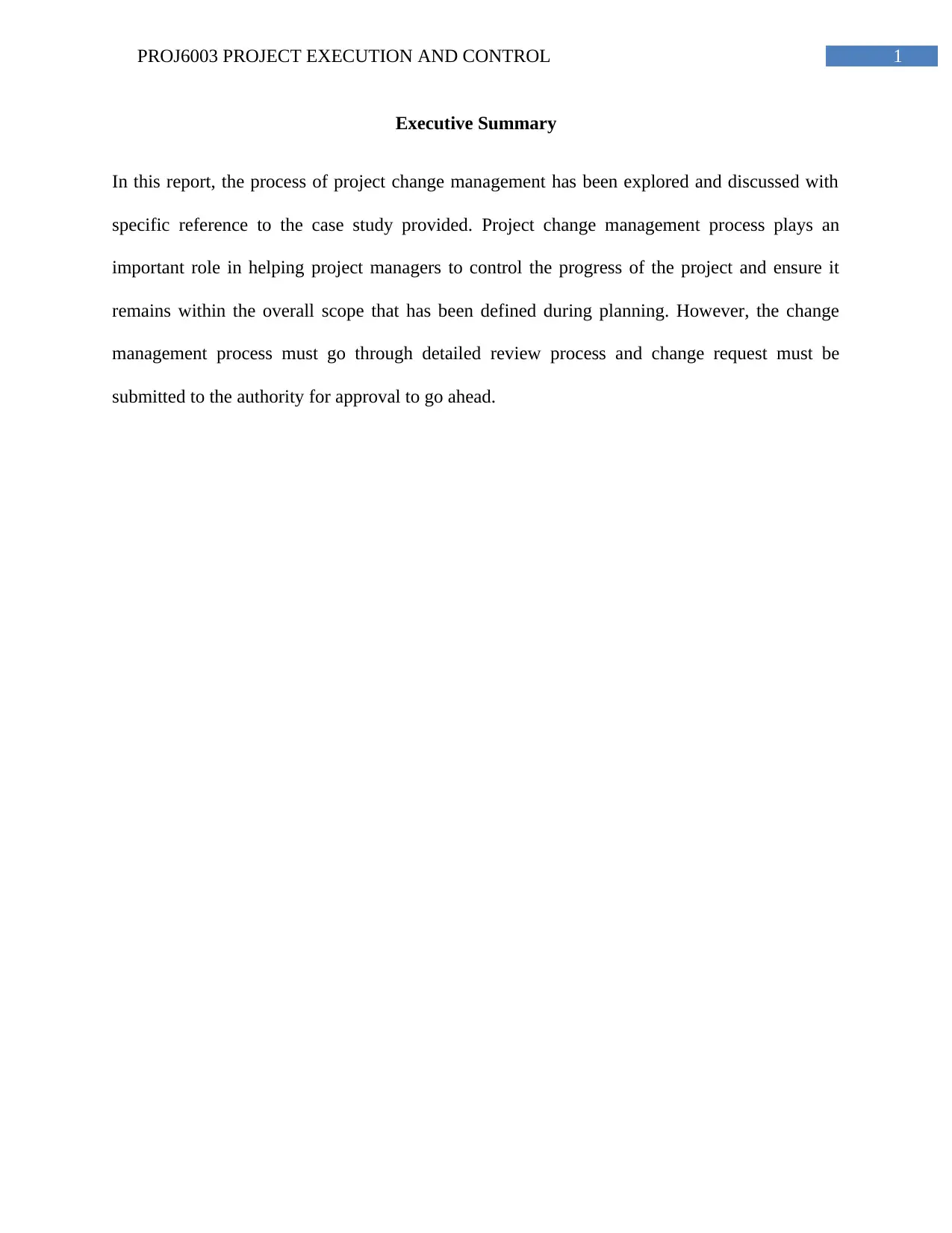
1PROJ6003 PROJECT EXECUTION AND CONTROL
Executive Summary
In this report, the process of project change management has been explored and discussed with
specific reference to the case study provided. Project change management process plays an
important role in helping project managers to control the progress of the project and ensure it
remains within the overall scope that has been defined during planning. However, the change
management process must go through detailed review process and change request must be
submitted to the authority for approval to go ahead.
Executive Summary
In this report, the process of project change management has been explored and discussed with
specific reference to the case study provided. Project change management process plays an
important role in helping project managers to control the progress of the project and ensure it
remains within the overall scope that has been defined during planning. However, the change
management process must go through detailed review process and change request must be
submitted to the authority for approval to go ahead.
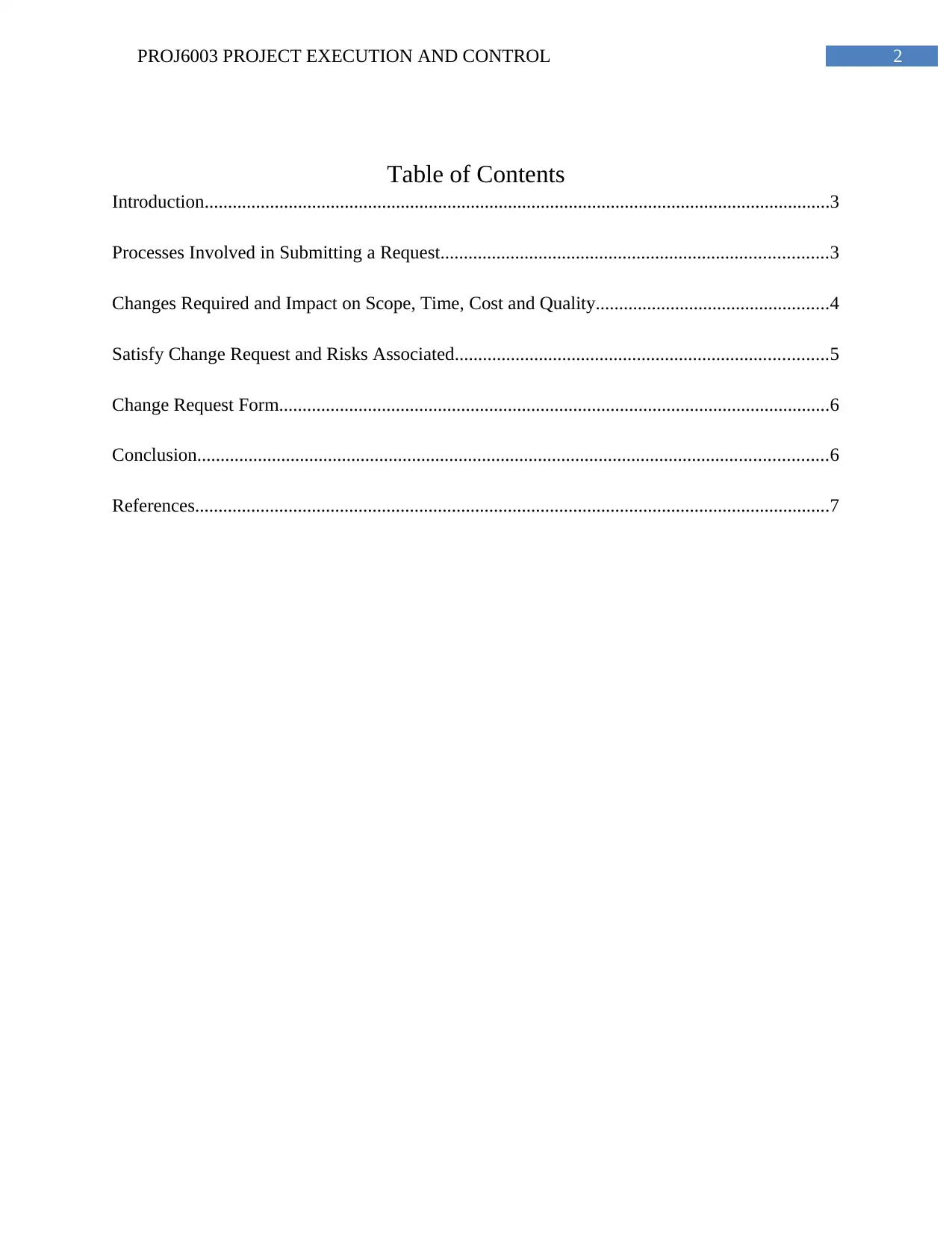
2PROJ6003 PROJECT EXECUTION AND CONTROL
Table of Contents
Introduction......................................................................................................................................3
Processes Involved in Submitting a Request...................................................................................3
Changes Required and Impact on Scope, Time, Cost and Quality..................................................4
Satisfy Change Request and Risks Associated................................................................................5
Change Request Form......................................................................................................................6
Conclusion.......................................................................................................................................6
References........................................................................................................................................7
Table of Contents
Introduction......................................................................................................................................3
Processes Involved in Submitting a Request...................................................................................3
Changes Required and Impact on Scope, Time, Cost and Quality..................................................4
Satisfy Change Request and Risks Associated................................................................................5
Change Request Form......................................................................................................................6
Conclusion.......................................................................................................................................6
References........................................................................................................................................7
⊘ This is a preview!⊘
Do you want full access?
Subscribe today to unlock all pages.

Trusted by 1+ million students worldwide
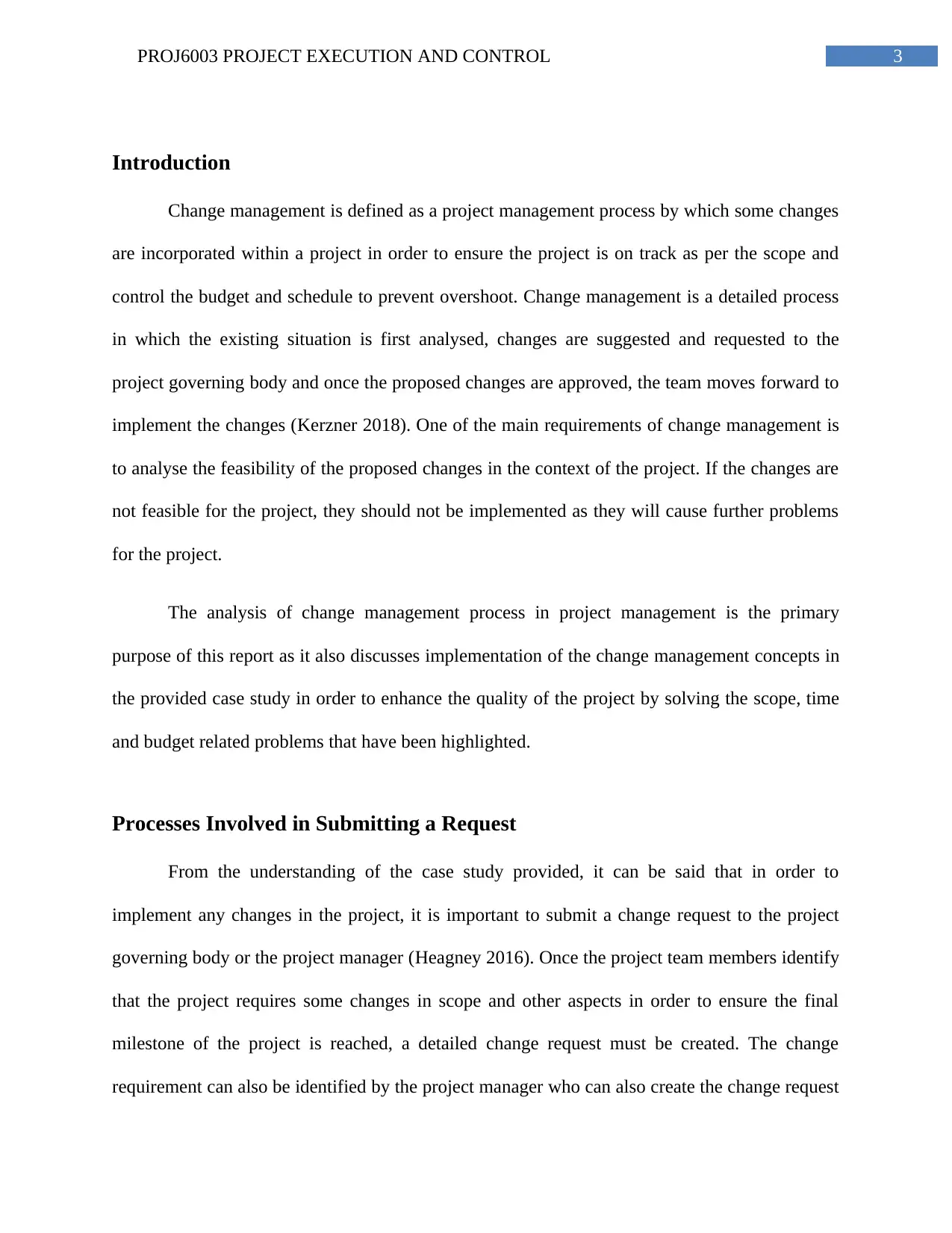
3PROJ6003 PROJECT EXECUTION AND CONTROL
Introduction
Change management is defined as a project management process by which some changes
are incorporated within a project in order to ensure the project is on track as per the scope and
control the budget and schedule to prevent overshoot. Change management is a detailed process
in which the existing situation is first analysed, changes are suggested and requested to the
project governing body and once the proposed changes are approved, the team moves forward to
implement the changes (Kerzner 2018). One of the main requirements of change management is
to analyse the feasibility of the proposed changes in the context of the project. If the changes are
not feasible for the project, they should not be implemented as they will cause further problems
for the project.
The analysis of change management process in project management is the primary
purpose of this report as it also discusses implementation of the change management concepts in
the provided case study in order to enhance the quality of the project by solving the scope, time
and budget related problems that have been highlighted.
Processes Involved in Submitting a Request
From the understanding of the case study provided, it can be said that in order to
implement any changes in the project, it is important to submit a change request to the project
governing body or the project manager (Heagney 2016). Once the project team members identify
that the project requires some changes in scope and other aspects in order to ensure the final
milestone of the project is reached, a detailed change request must be created. The change
requirement can also be identified by the project manager who can also create the change request
Introduction
Change management is defined as a project management process by which some changes
are incorporated within a project in order to ensure the project is on track as per the scope and
control the budget and schedule to prevent overshoot. Change management is a detailed process
in which the existing situation is first analysed, changes are suggested and requested to the
project governing body and once the proposed changes are approved, the team moves forward to
implement the changes (Kerzner 2018). One of the main requirements of change management is
to analyse the feasibility of the proposed changes in the context of the project. If the changes are
not feasible for the project, they should not be implemented as they will cause further problems
for the project.
The analysis of change management process in project management is the primary
purpose of this report as it also discusses implementation of the change management concepts in
the provided case study in order to enhance the quality of the project by solving the scope, time
and budget related problems that have been highlighted.
Processes Involved in Submitting a Request
From the understanding of the case study provided, it can be said that in order to
implement any changes in the project, it is important to submit a change request to the project
governing body or the project manager (Heagney 2016). Once the project team members identify
that the project requires some changes in scope and other aspects in order to ensure the final
milestone of the project is reached, a detailed change request must be created. The change
requirement can also be identified by the project manager who can also create the change request
Paraphrase This Document
Need a fresh take? Get an instant paraphrase of this document with our AI Paraphraser
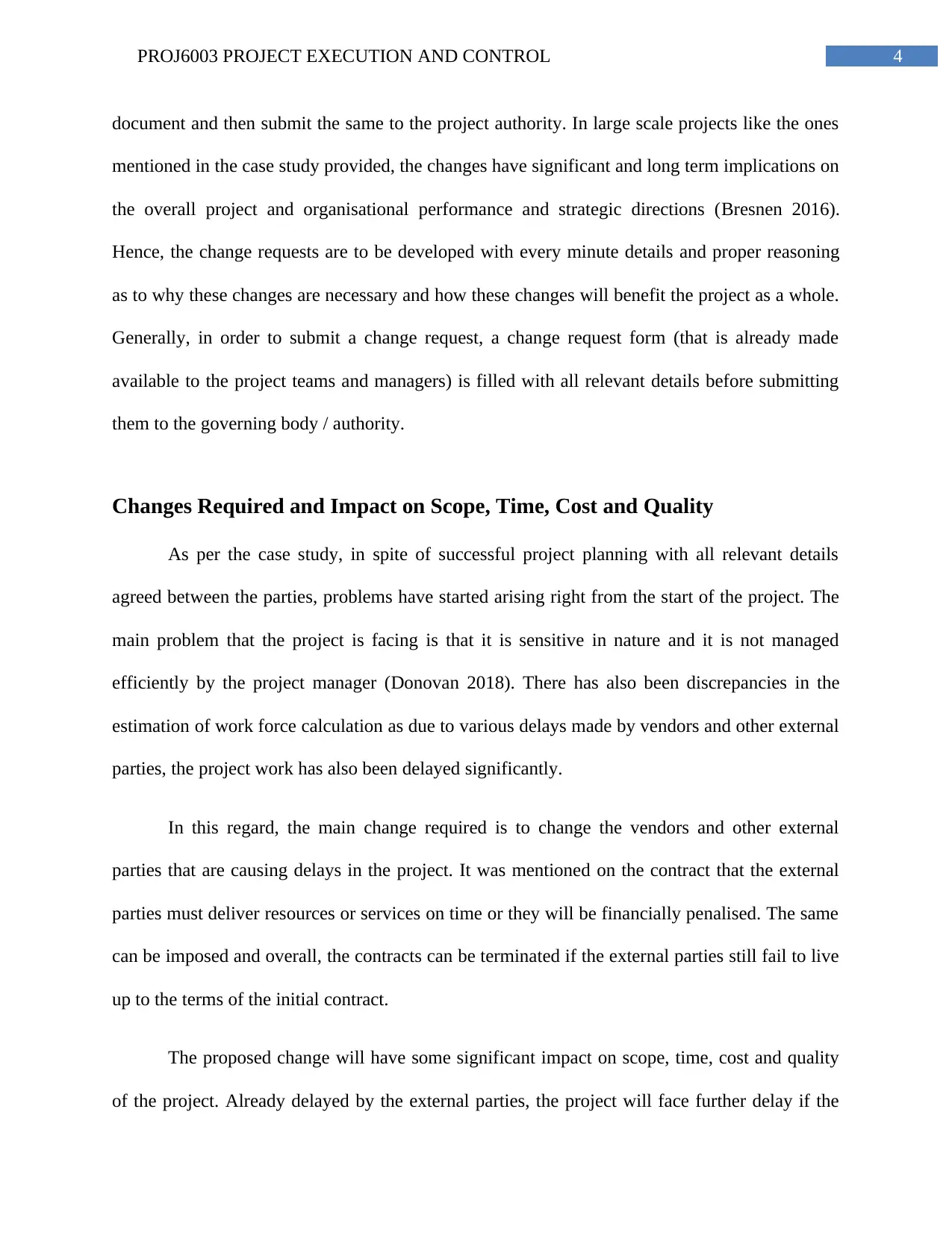
4PROJ6003 PROJECT EXECUTION AND CONTROL
document and then submit the same to the project authority. In large scale projects like the ones
mentioned in the case study provided, the changes have significant and long term implications on
the overall project and organisational performance and strategic directions (Bresnen 2016).
Hence, the change requests are to be developed with every minute details and proper reasoning
as to why these changes are necessary and how these changes will benefit the project as a whole.
Generally, in order to submit a change request, a change request form (that is already made
available to the project teams and managers) is filled with all relevant details before submitting
them to the governing body / authority.
Changes Required and Impact on Scope, Time, Cost and Quality
As per the case study, in spite of successful project planning with all relevant details
agreed between the parties, problems have started arising right from the start of the project. The
main problem that the project is facing is that it is sensitive in nature and it is not managed
efficiently by the project manager (Donovan 2018). There has also been discrepancies in the
estimation of work force calculation as due to various delays made by vendors and other external
parties, the project work has also been delayed significantly.
In this regard, the main change required is to change the vendors and other external
parties that are causing delays in the project. It was mentioned on the contract that the external
parties must deliver resources or services on time or they will be financially penalised. The same
can be imposed and overall, the contracts can be terminated if the external parties still fail to live
up to the terms of the initial contract.
The proposed change will have some significant impact on scope, time, cost and quality
of the project. Already delayed by the external parties, the project will face further delay if the
document and then submit the same to the project authority. In large scale projects like the ones
mentioned in the case study provided, the changes have significant and long term implications on
the overall project and organisational performance and strategic directions (Bresnen 2016).
Hence, the change requests are to be developed with every minute details and proper reasoning
as to why these changes are necessary and how these changes will benefit the project as a whole.
Generally, in order to submit a change request, a change request form (that is already made
available to the project teams and managers) is filled with all relevant details before submitting
them to the governing body / authority.
Changes Required and Impact on Scope, Time, Cost and Quality
As per the case study, in spite of successful project planning with all relevant details
agreed between the parties, problems have started arising right from the start of the project. The
main problem that the project is facing is that it is sensitive in nature and it is not managed
efficiently by the project manager (Donovan 2018). There has also been discrepancies in the
estimation of work force calculation as due to various delays made by vendors and other external
parties, the project work has also been delayed significantly.
In this regard, the main change required is to change the vendors and other external
parties that are causing delays in the project. It was mentioned on the contract that the external
parties must deliver resources or services on time or they will be financially penalised. The same
can be imposed and overall, the contracts can be terminated if the external parties still fail to live
up to the terms of the initial contract.
The proposed change will have some significant impact on scope, time, cost and quality
of the project. Already delayed by the external parties, the project will face further delay if the
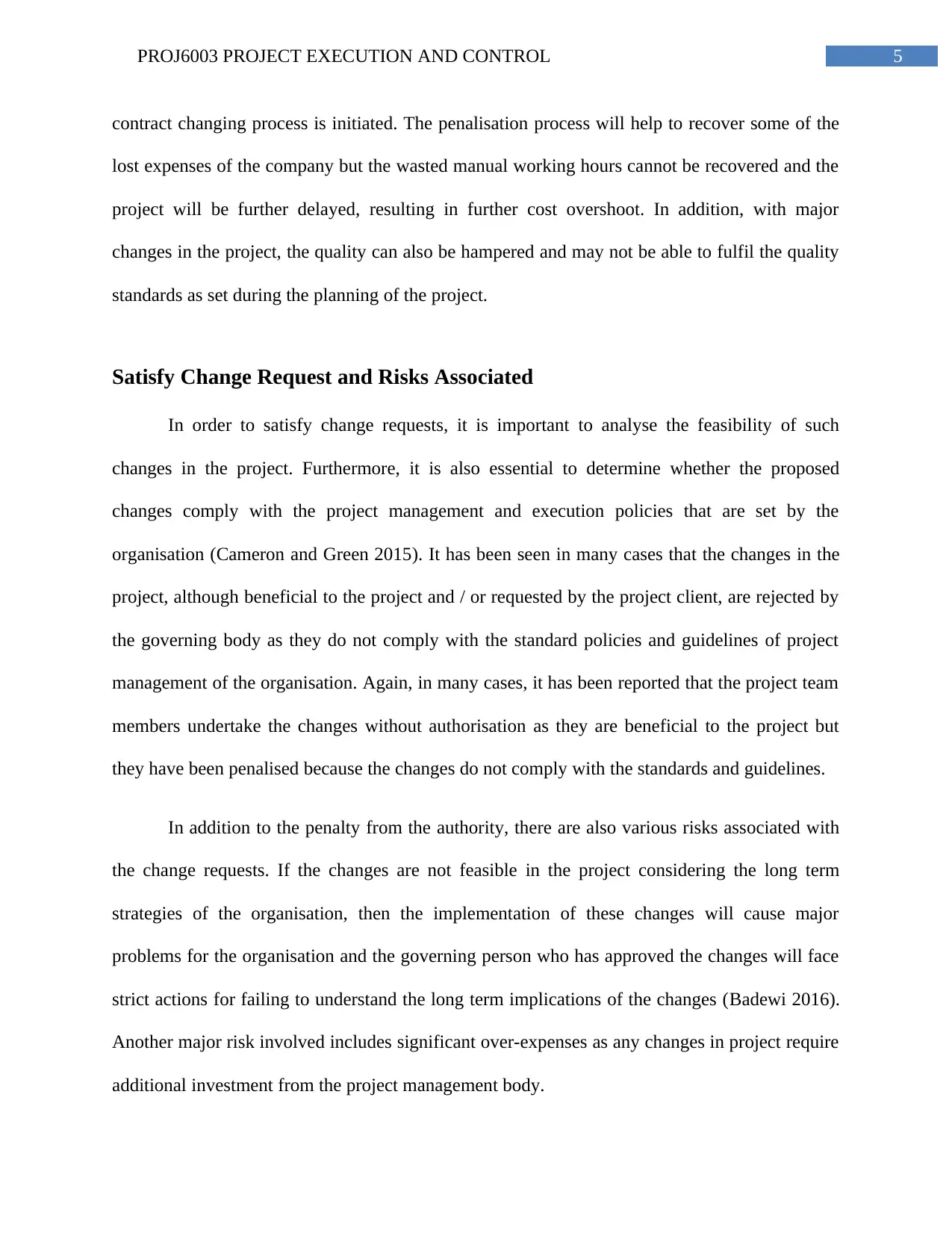
5PROJ6003 PROJECT EXECUTION AND CONTROL
contract changing process is initiated. The penalisation process will help to recover some of the
lost expenses of the company but the wasted manual working hours cannot be recovered and the
project will be further delayed, resulting in further cost overshoot. In addition, with major
changes in the project, the quality can also be hampered and may not be able to fulfil the quality
standards as set during the planning of the project.
Satisfy Change Request and Risks Associated
In order to satisfy change requests, it is important to analyse the feasibility of such
changes in the project. Furthermore, it is also essential to determine whether the proposed
changes comply with the project management and execution policies that are set by the
organisation (Cameron and Green 2015). It has been seen in many cases that the changes in the
project, although beneficial to the project and / or requested by the project client, are rejected by
the governing body as they do not comply with the standard policies and guidelines of project
management of the organisation. Again, in many cases, it has been reported that the project team
members undertake the changes without authorisation as they are beneficial to the project but
they have been penalised because the changes do not comply with the standards and guidelines.
In addition to the penalty from the authority, there are also various risks associated with
the change requests. If the changes are not feasible in the project considering the long term
strategies of the organisation, then the implementation of these changes will cause major
problems for the organisation and the governing person who has approved the changes will face
strict actions for failing to understand the long term implications of the changes (Badewi 2016).
Another major risk involved includes significant over-expenses as any changes in project require
additional investment from the project management body.
contract changing process is initiated. The penalisation process will help to recover some of the
lost expenses of the company but the wasted manual working hours cannot be recovered and the
project will be further delayed, resulting in further cost overshoot. In addition, with major
changes in the project, the quality can also be hampered and may not be able to fulfil the quality
standards as set during the planning of the project.
Satisfy Change Request and Risks Associated
In order to satisfy change requests, it is important to analyse the feasibility of such
changes in the project. Furthermore, it is also essential to determine whether the proposed
changes comply with the project management and execution policies that are set by the
organisation (Cameron and Green 2015). It has been seen in many cases that the changes in the
project, although beneficial to the project and / or requested by the project client, are rejected by
the governing body as they do not comply with the standard policies and guidelines of project
management of the organisation. Again, in many cases, it has been reported that the project team
members undertake the changes without authorisation as they are beneficial to the project but
they have been penalised because the changes do not comply with the standards and guidelines.
In addition to the penalty from the authority, there are also various risks associated with
the change requests. If the changes are not feasible in the project considering the long term
strategies of the organisation, then the implementation of these changes will cause major
problems for the organisation and the governing person who has approved the changes will face
strict actions for failing to understand the long term implications of the changes (Badewi 2016).
Another major risk involved includes significant over-expenses as any changes in project require
additional investment from the project management body.
⊘ This is a preview!⊘
Do you want full access?
Subscribe today to unlock all pages.

Trusted by 1+ million students worldwide
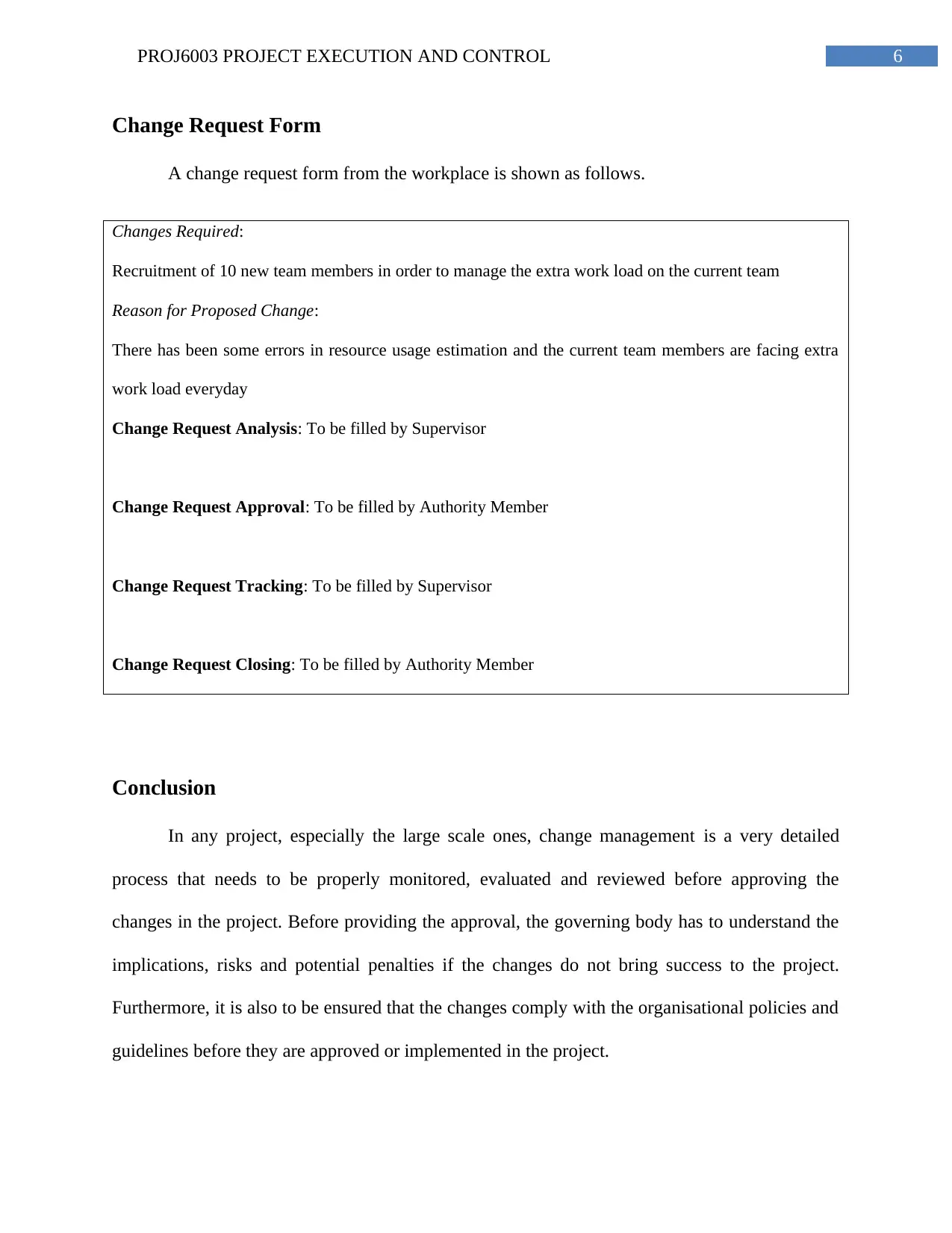
6PROJ6003 PROJECT EXECUTION AND CONTROL
Change Request Form
A change request form from the workplace is shown as follows.
Changes Required:
Recruitment of 10 new team members in order to manage the extra work load on the current team
Reason for Proposed Change:
There has been some errors in resource usage estimation and the current team members are facing extra
work load everyday
Change Request Analysis: To be filled by Supervisor
Change Request Approval: To be filled by Authority Member
Change Request Tracking: To be filled by Supervisor
Change Request Closing: To be filled by Authority Member
Conclusion
In any project, especially the large scale ones, change management is a very detailed
process that needs to be properly monitored, evaluated and reviewed before approving the
changes in the project. Before providing the approval, the governing body has to understand the
implications, risks and potential penalties if the changes do not bring success to the project.
Furthermore, it is also to be ensured that the changes comply with the organisational policies and
guidelines before they are approved or implemented in the project.
Change Request Form
A change request form from the workplace is shown as follows.
Changes Required:
Recruitment of 10 new team members in order to manage the extra work load on the current team
Reason for Proposed Change:
There has been some errors in resource usage estimation and the current team members are facing extra
work load everyday
Change Request Analysis: To be filled by Supervisor
Change Request Approval: To be filled by Authority Member
Change Request Tracking: To be filled by Supervisor
Change Request Closing: To be filled by Authority Member
Conclusion
In any project, especially the large scale ones, change management is a very detailed
process that needs to be properly monitored, evaluated and reviewed before approving the
changes in the project. Before providing the approval, the governing body has to understand the
implications, risks and potential penalties if the changes do not bring success to the project.
Furthermore, it is also to be ensured that the changes comply with the organisational policies and
guidelines before they are approved or implemented in the project.
Paraphrase This Document
Need a fresh take? Get an instant paraphrase of this document with our AI Paraphraser
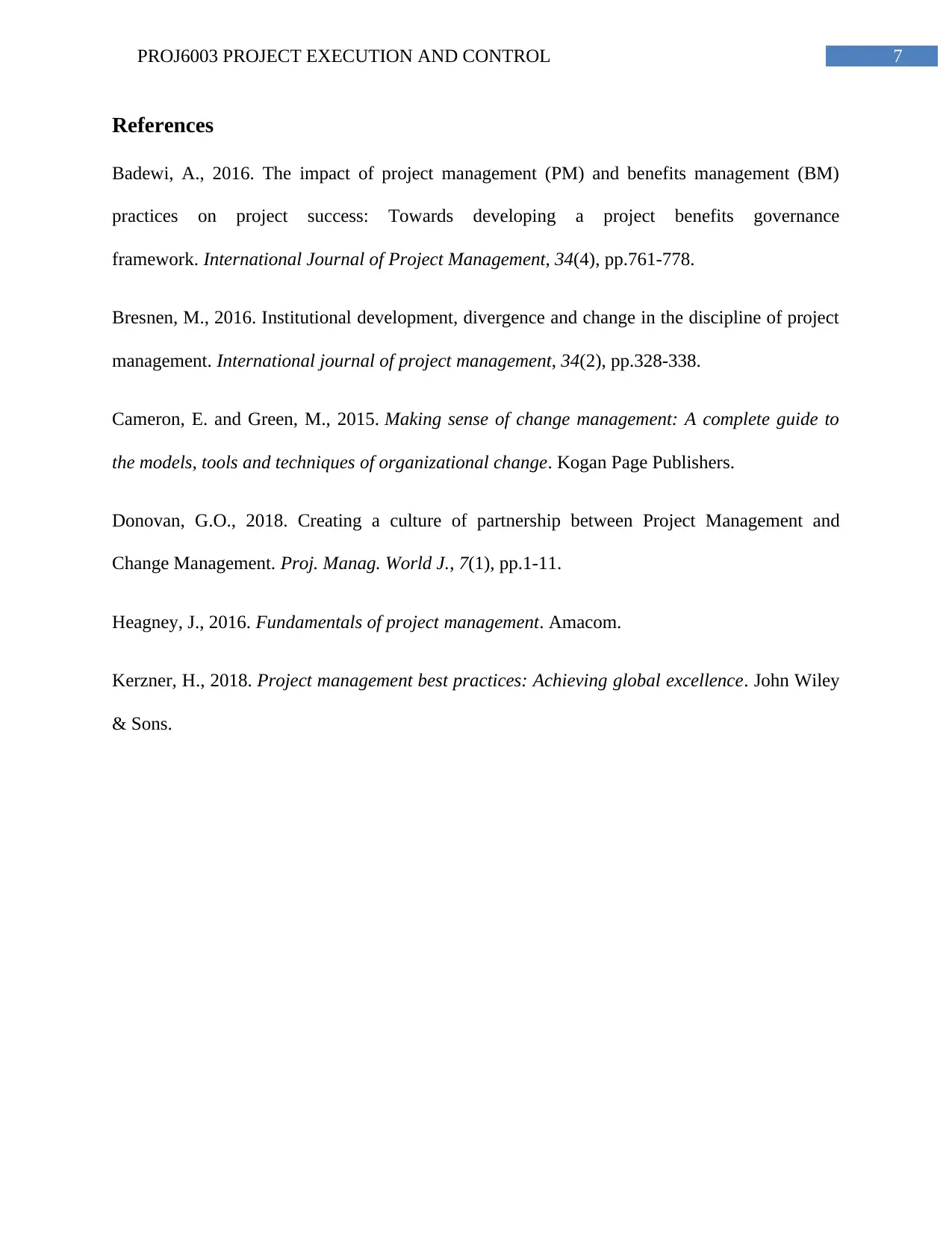
7PROJ6003 PROJECT EXECUTION AND CONTROL
References
Badewi, A., 2016. The impact of project management (PM) and benefits management (BM)
practices on project success: Towards developing a project benefits governance
framework. International Journal of Project Management, 34(4), pp.761-778.
Bresnen, M., 2016. Institutional development, divergence and change in the discipline of project
management. International journal of project management, 34(2), pp.328-338.
Cameron, E. and Green, M., 2015. Making sense of change management: A complete guide to
the models, tools and techniques of organizational change. Kogan Page Publishers.
Donovan, G.O., 2018. Creating a culture of partnership between Project Management and
Change Management. Proj. Manag. World J., 7(1), pp.1-11.
Heagney, J., 2016. Fundamentals of project management. Amacom.
Kerzner, H., 2018. Project management best practices: Achieving global excellence. John Wiley
& Sons.
References
Badewi, A., 2016. The impact of project management (PM) and benefits management (BM)
practices on project success: Towards developing a project benefits governance
framework. International Journal of Project Management, 34(4), pp.761-778.
Bresnen, M., 2016. Institutional development, divergence and change in the discipline of project
management. International journal of project management, 34(2), pp.328-338.
Cameron, E. and Green, M., 2015. Making sense of change management: A complete guide to
the models, tools and techniques of organizational change. Kogan Page Publishers.
Donovan, G.O., 2018. Creating a culture of partnership between Project Management and
Change Management. Proj. Manag. World J., 7(1), pp.1-11.
Heagney, J., 2016. Fundamentals of project management. Amacom.
Kerzner, H., 2018. Project management best practices: Achieving global excellence. John Wiley
& Sons.
1 out of 8
Related Documents
Your All-in-One AI-Powered Toolkit for Academic Success.
+13062052269
info@desklib.com
Available 24*7 on WhatsApp / Email
![[object Object]](/_next/static/media/star-bottom.7253800d.svg)
Unlock your academic potential
Copyright © 2020–2025 A2Z Services. All Rights Reserved. Developed and managed by ZUCOL.



